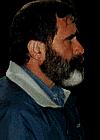 Dr. Clyde F. E. Roper, a marine biologist at the Smithsonian's National Museum of Natural History
in Washington, DC, is currently leading an international team of more than
a dozen scientists on an expedition to study the biodiversity and habitat of
the Kaikoura Canyon, a rich
deep-sea ecosystem off New Zealand's South Island. The steep canyon is part
of an enormous, little-explored trench system that is home to sperm whales
and other sea fauna, natural anticarcinogens and Architeuthis, the giant squid. The giant
squid, which can reach 60 feet in length, has never been observed alive in its
natural habitat.
Dr. Clyde F. E. Roper, a marine biologist at the Smithsonian's National Museum of Natural History
in Washington, DC, is currently leading an international team of more than
a dozen scientists on an expedition to study the biodiversity and habitat of
the Kaikoura Canyon, a rich
deep-sea ecosystem off New Zealand's South Island. The steep canyon is part
of an enormous, little-explored trench system that is home to sperm whales
and other sea fauna, natural anticarcinogens and Architeuthis, the giant squid. The giant
squid, which can reach 60 feet in length, has never been observed alive in its
natural habitat.
Included in the team are the Massachusetts Institute of Technology's Sea Grant
Autonomous Underwater
Vehicles Lab, the Cornell
University's Lab of Ornithology, and the New Zealand
National Institutes of Water and
Atmosphere. In addition,
National
Geographic Television, the world renowned producer of National
Geographic specials will film the expedition. It is anticipated that
people from around the world will be able to share in the day to day
activities during the expedition, live on the
World Wide Web.
![]()
![]() One way to study the inhabitants of Kaikoura Canyon, and potentially observe the giant squid first hand, is to lower a robotic,
autonomous underwater vehicle
into the frigid, inky depths where sperm whales feed. Scientists can
use powerful lights, cameras and listening devices in the vehicle to
observe the hunter and the hunted. Even a brief glimpse of a giant
squid could answer many questions about its habitat and morphology, its
interaction with other deep sea denizens, and even what it eats and how
it swims. Leading the AUV team is Dr. James G. Bellingham, Prinicipal Research Engineer and the Manager of the MIT Sea Grant Underwater Vehicles Laboratory.
One way to study the inhabitants of Kaikoura Canyon, and potentially observe the giant squid first hand, is to lower a robotic,
autonomous underwater vehicle
into the frigid, inky depths where sperm whales feed. Scientists can
use powerful lights, cameras and listening devices in the vehicle to
observe the hunter and the hunted. Even a brief glimpse of a giant
squid could answer many questions about its habitat and morphology, its
interaction with other deep sea denizens, and even what it eats and how
it swims. Leading the AUV team is Dr. James G. Bellingham, Prinicipal Research Engineer and the Manager of the MIT Sea Grant Underwater Vehicles Laboratory.
 Emory Kristof, the
renowned deep-sea photographer for National Geographic will use the Ropecam system he developed, as another method of exploring the abyssal depths
of Kaikoura Canyon. The Ropecam positions a video camera at depths
ranging from 500 to 6,000 feet to record images of animals attracted to
bait pumped out by the system. The Ropecam images will be
interpreted by a team of scientists led by Greg Stone, associate director
of conservation programs at Boston's New England Aquarium.
Emory Kristof, the
renowned deep-sea photographer for National Geographic will use the Ropecam system he developed, as another method of exploring the abyssal depths
of Kaikoura Canyon. The Ropecam positions a video camera at depths
ranging from 500 to 6,000 feet to record images of animals attracted to
bait pumped out by the system. The Ropecam images will be
interpreted by a team of scientists led by Greg Stone, associate director
of conservation programs at Boston's New England Aquarium.
Smithsonian Giant Squid Overview Page
gene carl feldman / gene@seawifs.gsfc.nasa.gov